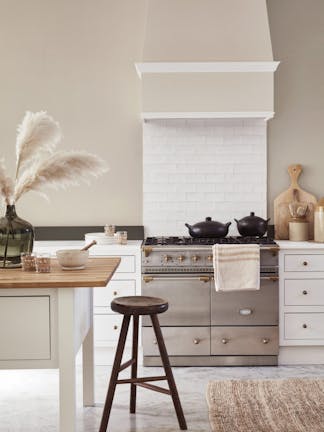The modern kitchen has a long list of important jobs to do. It’s where you cook, dine and entertain, meaning beauty and practicality are both equal considerations when designing or updating your kitchen.
With this in mind, the Little Greene chemists have designed a paint finish for exactly that. Our ‘Intelligent Satin’ paint is the ideal finish for kitchen cabinets. The paint dries to a beautiful mid sheen, providing protection, longevity and a smooth satin feel to your kitchen doors and woodwork, without being too glossy. This means you don’t have to compromise on beauty or practicality; you can choose your favourite Little Greene shade safe in the knowledge it can withstand the wear and tear of modern family life.
Step by step guide - How to paint kitchen cabinets
We’ve produced this step-by-step guide to painting your kitchen cabinets using ‘Intelligent Satin’ and ‘Intelligent ASP’ (All Surface Primer)

Priming & Preparation
- Remove the kitchen handles first, followed by removing the whole door from the hinge.
- If you’re painting onto new or bare wood, ensure that the doors are completely clean and any resinous knots in softwood and all hardwoods are sealed with knotting compound.
- Previously painted woodwork must be thoroughly cleaned and sanded, removing any loose or flaking paint. Wipe down with a lint free cloth.
- Apply one coat of ‘Intelligent ASP’ (all surface primer). This will help you to achieve your desired colour with fewer topcoats, as well as priming the surface ready for painting. Once applied, it will be dry within two hours.
Q: Can I use Little Greene on vinyl, MDF or previously painted doors?
Yes you can – but you will need to prepare the surface with ‘Intelligent ASP’ (our All Surface Primer) beforehand.

Painting
- Ensure the wood is completely dry before painting.
- Stir ‘Intelligent Satin’ paint thoroughly before use. Evenly apply the first coat and allow to dry. Paint the panels in smooth, even strokes in the direction of the grain, rather than against it.
- Your doors will be dry to the touch within 2-4 hours, but you will need to wait 4 hours before re-applying the second coat.
- Apply a second coat of ‘Intelligent Satin’.
- Two full coats of ‘Intelligent Satin’ are recommended to achieve full depth of colour.
- Once dry, re-attach your doors to the hinges, followed by the handles for the finishing touch.

Painting tips from the experts
- Paint the panels in smooth, even strokes in the direction of the grain, rather than against it.
- For flat kitchen doors, we would recommend using a short nap, wool blend sleeve for best appearance on smooth surfaces.
- Increase the nap length for more textured doors, as appropriate, to ensure even and thorough coverage.
- Ensure the final strokes are all in the same direction, maintain a wet edge throughout.
- Never be tempted to go over already drying paint as this may lead to marking and flashing.
Discover our guide to choosing colours for your kitchen.
For more kitchen and dining room décor ideas, browse our inspiration gallery.

